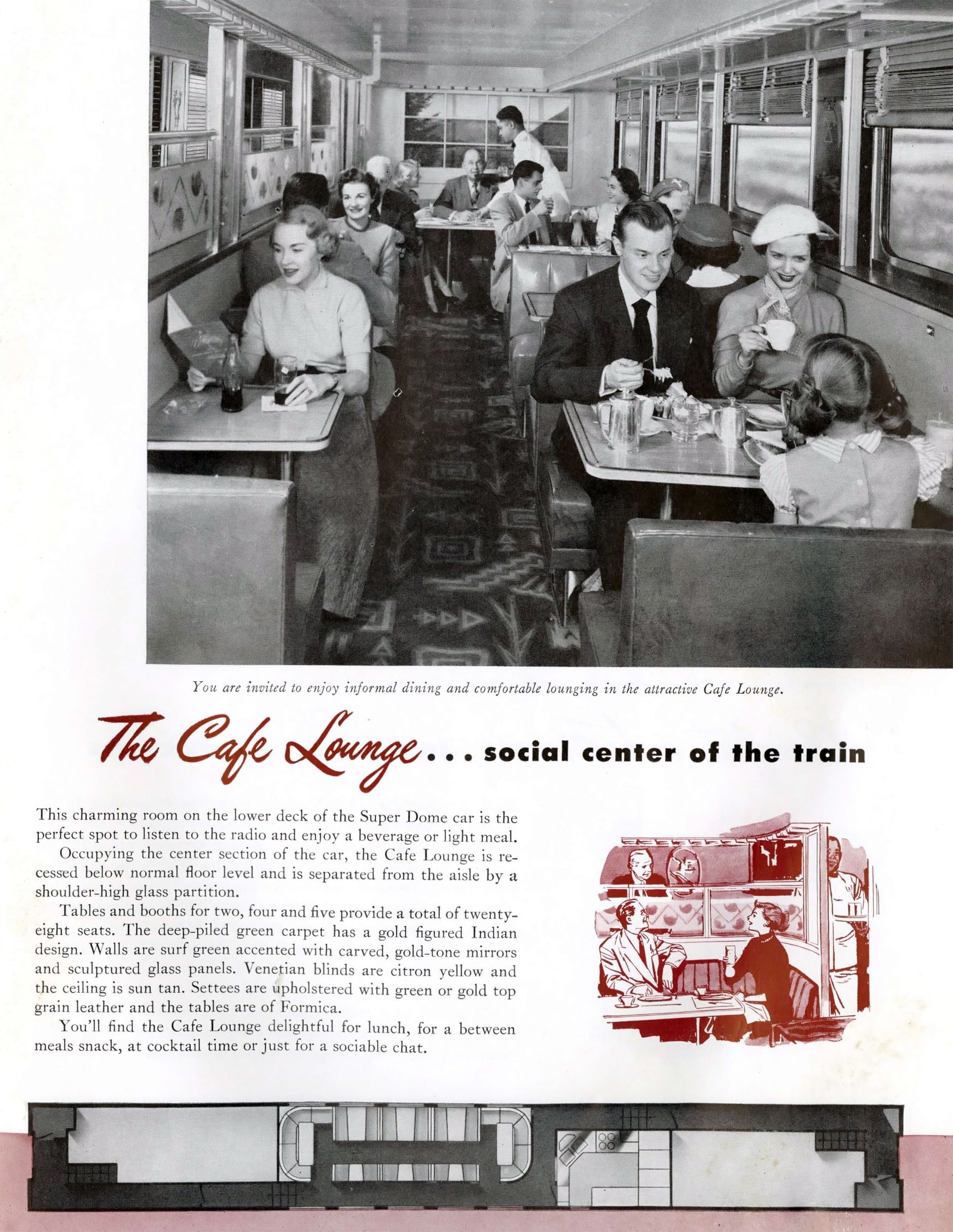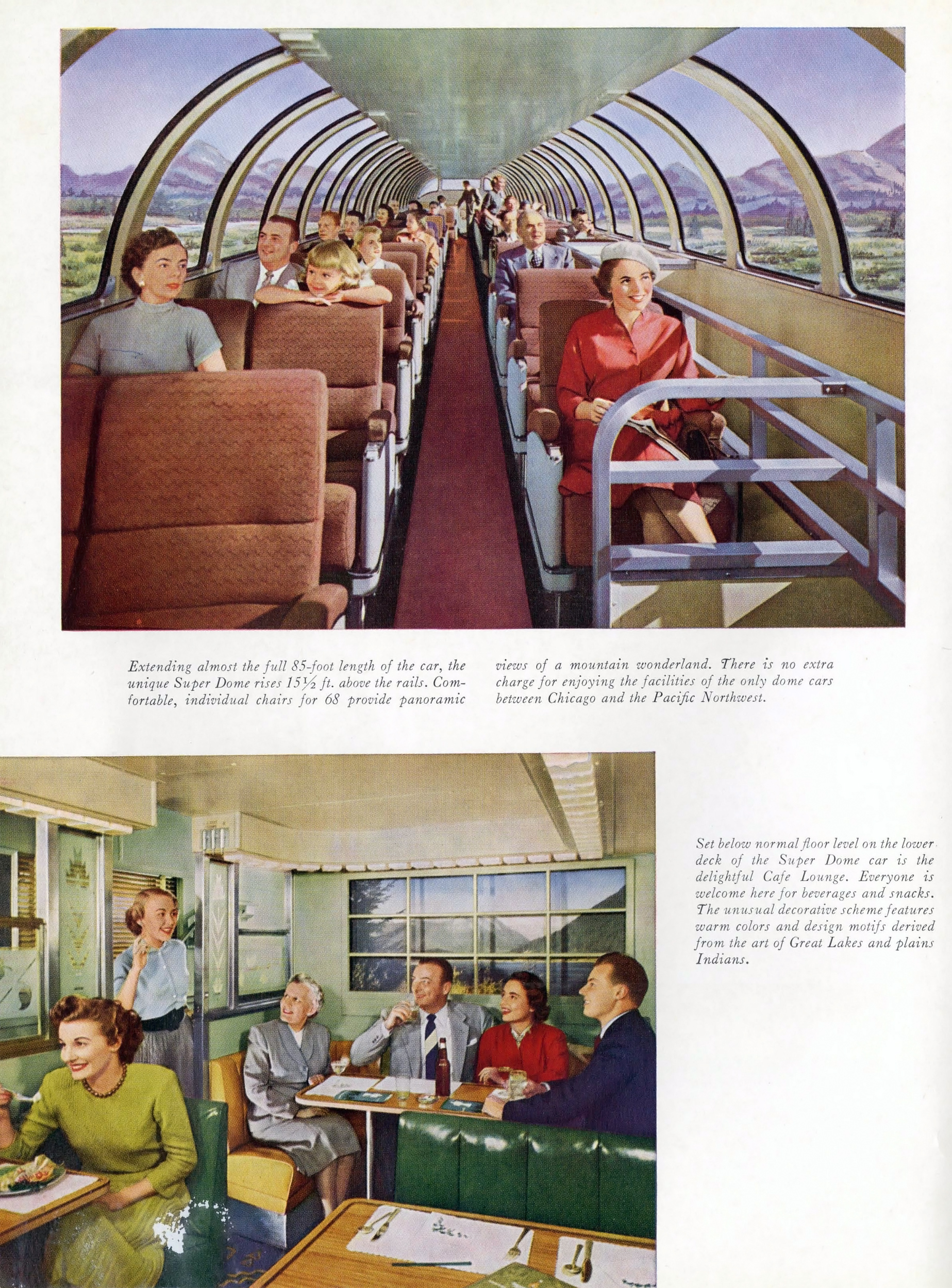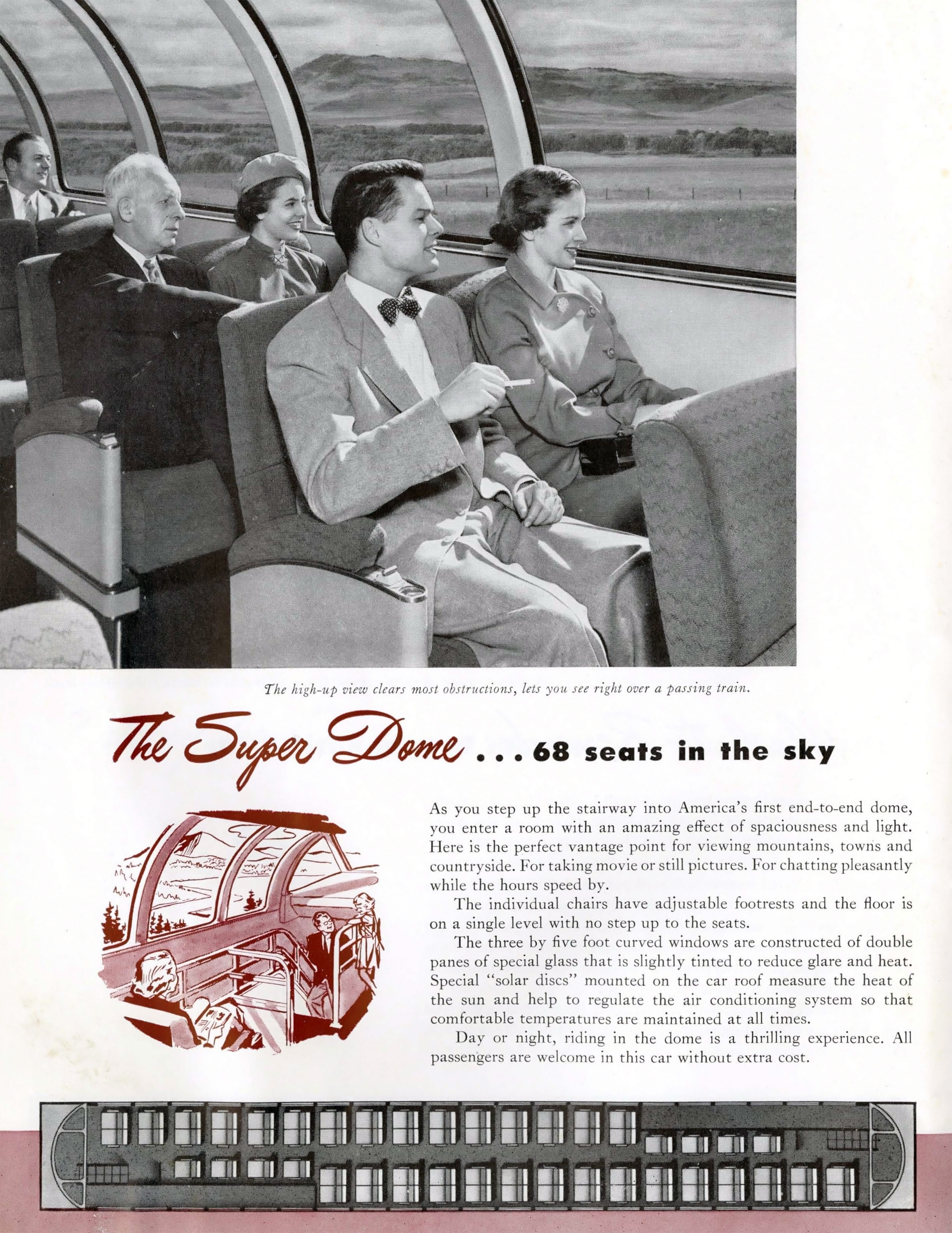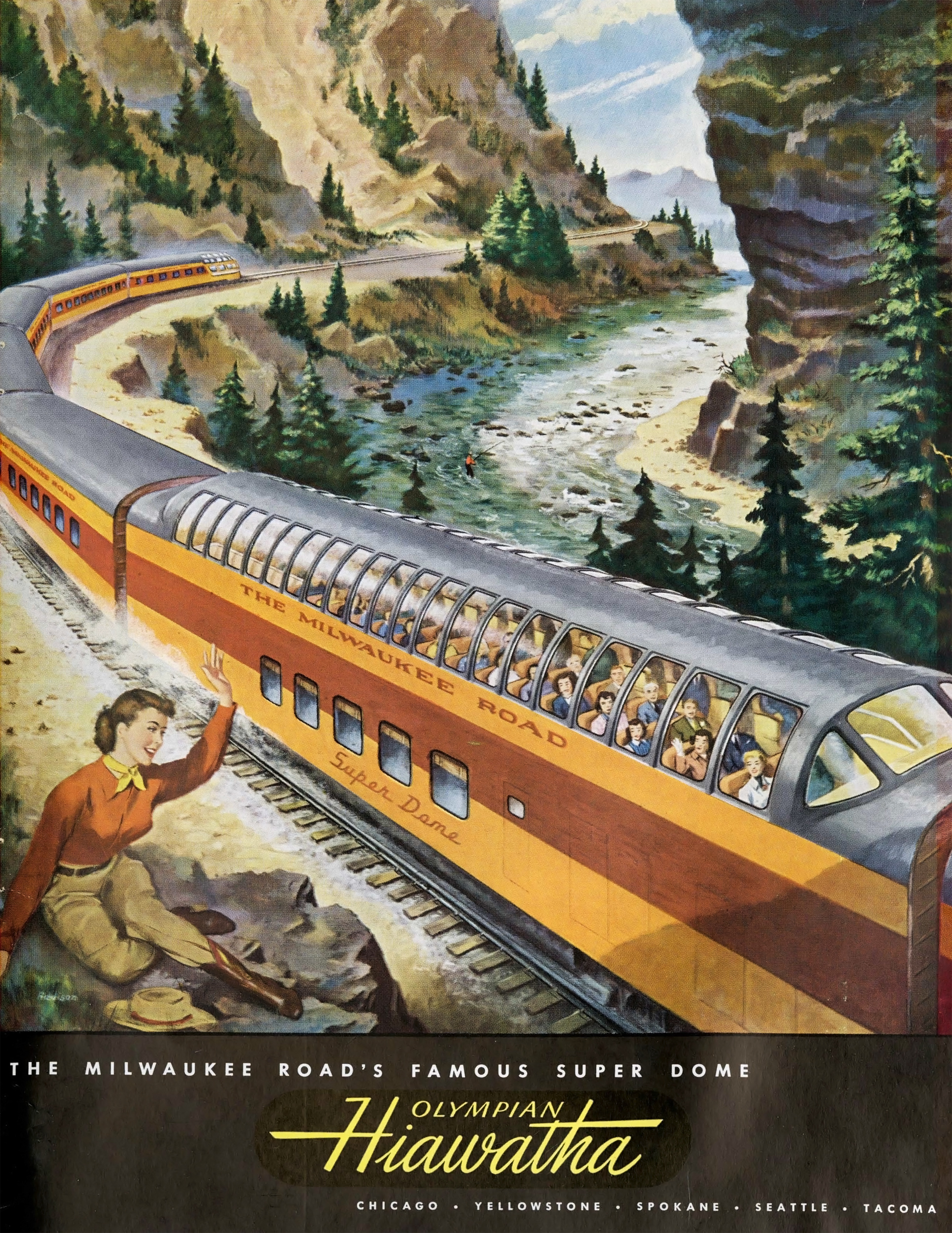The Super Domes: Enhancing The "Olympian Hiawatha"
Published: February 6, 2025
By: Adam Burns
The Milwaukee Road's "Super Domes" were exotic for their time as the first full length domes to operate on an American railroad when they entered service in 1952.
In junction with Pullman-Standard the railroad had ten such cars built for its transcontinental Olympian Hiawatha and expanded upon the mid-car raised solariums on designs like the Vista-Dome that had been in service since the mid-1940s.
When introduced in the mid-20th century, these railcars represented not only a pinnacle of luxury but also an emblematic shift in the competitive landscape of passenger rail service.
With an eye towards both innovation and customer satisfaction, the Milwaukee Road embarked on a journey to redefine the passenger experience, a journey that is still admired by rail enthusiasts and historians today.
When the railroad canceled the Olympian Hiawatha in 1961 the cars were sold to the Canadian National for service on the Super Continental. Four cars were later purchased by Amtrak on various western trains, as well as the Auto Train.
Design
The introduction of the Super Dome railcars was a strategic move to enhance the appeal of the Milwaukee Road's flagship "Hiawatha" line, which ran from Chicago to the major Midwestern hubs of Minneapolis and St. Paul.
By the 1940s and 1950s, the allure of rail travel had begun to wane with the advent of more accessible airlines and the burgeoning interstate highway system.
Railroads were thus compelled to innovate both technologically and experientially to retain and attract passengers. The Milwaukee Road, known for its progressive thinking, responded with the creation of the Super Dome in conjunction with Pullman-Standard which had been experimenting with a full-length dome car in the postwar era.
Numbered 50-59, the Super Domes were a marvel of engineering and design, first rolled out in 1952.
The name originated from an employee naming contest, with alternative proposed names such as Master Dome, Ultra Dome, and Panorama Dome being rejected. The Super Domes were deployed on the daytime Twin Cities Hiawatha and the transcontinental Olympian Hiawatha routes.
Notably, the Super Domes were the sole cars on a daytime Hiawatha route constructed by an external entity; all other Hiawatha machinery, including the distinctive Beaver Tail and Skytop lounges, were constructed in the Milwaukee Road's own facilities.

Specifications
This architectural marvel consisted of glass panes arranged in a sleek, aerodynamic configuration, offering unrivaled panoramic views of the surrounding countryside. These vistas were critical to the appeal of the Super Dome, transforming every journey into an immersive travel experience.
Inside, the Super Dome cars were no less spectacular. The upper deck was furnished with plush seats, enabling passengers to indulge in breathtaking scenery from virtually every angle — a novelty that other rail providers rushed to replicate.
The dome level was supplemented by a lower level that included a comfortable lounge area with 28 seats and a bar, creating a social hub where passengers could congregate and enjoy the finer points of their journey.
Amenities such as air conditioning, reduced noise, and innovative suspension systems further elevated the travel experience, establishing a standard for comfort that significantly enhanced the Milwaukee Road’s appeal.
Each Super Dome was constructed at a cost of $320,000, an exorbitant sum for its era. Designed with upper-level seating for 68 passengers, the Super Dome's capacity was nearly triple that of the conventional dome cars employed by other railways.
Each unit measured 85 feet in length, 10 feet in width, and stood at 15 feet, 6 inches in height. The body alone weighed in at 134,050 pounds, while each of its six-wheel trucks accounted for 66,550 pounds. When fully operational and loaded with passengers, these cars reached an approximate total weight of 224,080 pounds.
The Super Domes came equipped with a self-contained diesel power plant that provided heating and lighting independent of the main train system.
This included two Waukesha diesel Enginator generators. Inspired by Milwaukee’s innovation, other railroads such as Great Northern and Santa Fe also commissioned full-length domes similar to Milwaukee’s. In contrast, Southern Pacific opted for domes with open galleries offering seating on a lower tier.

Functionally, the Super Dome cars were innovative as well. Their integration into the Hiawatha service provided a boost not only aesthetically but operationally. By offering unique amenities, the cars attracted a wealthier class of patrons who cherished both comfort and exclusivity.
These patrons often preferred rail travel due to its leisurely pace and camaraderie, qualities the airlines at the time could not replicate. As a result, the Super Dome helped magnify the Milwaukee Road's reputation for providing dignified, high-class service, thereby carving a distinct niche in the competitive domain of passenger railroads.
Operational Issues
However, the Super Domes did not achieve complete success within the Milwaukee Road's service. Due to their heavy structure, they provided a rather unsteady ride, and the seating in the dome area offered suboptimal views as they were positioned too low relative to the supporting bulkheads of the dome.
A notable limitation of the full-length dome design was its inability to afford passengers clear forward and rear views, a feature that had been readily available in the 24-seat dome cars, thereby compromising the full panoramic experience.
Nonetheless, the distinction of being the first full-length dome car conferred significant promotional value on the railroad.
Following the discontinuation of the Olympian Hiawatha in 1961, Super Domes appeared on some of the Milwaukee Road's services conducted in collaboration with the Union Pacific, such as the City of Denver.
In 1964, the Milwaukee Road sold six of these domes to the Canadian National Railway, along with the sleeper-lounge Skytop Lounges. The remaining four domes remained in operation on the Twin Cities Hiawatha route.

Decline
Yet in an era of ever-evolving transportation needs, the heyday of the Super Dome was relatively brief. The 1960s saw a consolidation within the railroad industry, driven by financial pressures and changing consumer preferences.
The rise of the automobile and growing reliance on aviation led to a decreased demand for long-distance passenger trains. Despite the Super Dome's allure and innovative design, the Milwaukee Road faced challenges sustaining its rejuvenated services.
Increasing operational costs and declining ridership would eventually bring down the Hiawatha service, leading to the gradual phase-out of the Super Dome cars from active service.
Nevertheless, the legacy of the Milwaukee Road’s Super Dome railcars endures in several enduring ways. Many of these iconic cars have been preserved and can be seen today on various excursion trains and are displayed in rail museums, standing as testaments to a golden era of rail travel.
Moreover, the pioneering spirit of the Super Dome's design and service strategy continues to inspire contemporary rail initiatives that seek to recapture and redeploy the magic of train travel for modern audiences.
Though the Super Domes were significantly heavier, contradicting Milwaukee's former commitment to lightweight designs, by the early 1950s, the era of Milwaukee's Hiawatha sprinting at velocities exceeding 110 miles per hour on tight schedules was in decline. Contributing factors included the Interstate Commerce Commission's 1947 decision and the burgeoning commercial airline industry, both of which led to a reduction in American passenger train speeds. Railroads like Milwaukee had shifted their emphasis from competing in the high-speed travel sector to prioritizing luxurious travel experiences and promoting the scenic vistas visible from their trains.
Legacy
In conclusion, the Super Dome cars weren't just a radical departure from the utilitarian train coaches of the early 20th century; they represented a new vision of rail travel where comfort, luxury, and innovation intersected.
The Milwaukee Road’s venture into dome car services was both a technological and experiential revolution, a bold statement in a time of transition that, even today, serves as a reminder of the indelible mark left by rail travel on the cultural landscape.
As history looks fondly back at these splendid railcars, they remain an embodiment of a cherished epoch in railroad history, symbolizing the zenith of rail-based luxury and the enduring quest to connect people, places, and the unfolding spectacle of nature’s panoramas.
Preservation
Numerous Super Domes continue to operate, predominantly on heritage railways. A notable instance is car number 52, which, after serving the Milwaukee Road, Canadian National, VIA Rail, and various private operators for many years, has been incorporated into the Napa Valley Wine Train since 1995.
Another significant car, number 53, typically runs attached to the Milwaukee Road 261. Car 55 has been redesignated as Reading, Blue Mountain and Northern Railroad Car 4, while car 59 is now Reading & Northern Car 5. Additionally, Canadian National maintains one in active service within their executive train fleet.
Recent Articles
-
Baltimore Penn Station: PRR's Historic Terminal
Feb 07, 25 12:18 AM
Baltimore Penn Station, formerly Union Station, is a former PRR facility that opened in 1911 and remains in use under Amtrak today. -
The Super Domes: Enhancing The "Olympian Hiawatha"
Feb 06, 25 11:59 PM
The Super Domes included a group of ten full length dome cars manufactured by Pullman-Standard for -
The Vista-Dome: A Jewel Of Mid-Century Rail Travel
Feb 06, 25 12:27 PM
The Vista-Dome kicked off the modern dome car movement, introduced in 1945. The car could often be found on the Great Northern, Northern Pacific and CB&Q. Today, several are preserved.



